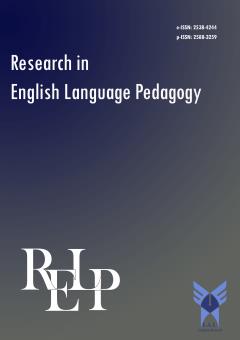A Corpus-Based Study of Academic Vocabulary in Sociology Research Articles: Which Words Should a Teacher Concentrate on?
الموضوعات : Research in English Language PedagogyReza Bagheri Nevisi 1 , Mahmood Safari 2 , Mahnaz Seddighi 3
1 - Department of English Language and Literature, University of Qom, Qom, Iran
2 - English Department, Hazrat-e Masoumeh University, Qom, Iran
3 - Department of English Language and Literature, University of Qom, Qom, Iran
الکلمات المفتاحية: Academic Word List, English for Specific Purposes, Sociology, Technical Words, Word Families,
ملخص المقالة :
There have always been too many words in a new language to learn. Therefore, prioritizing important words over the others for learning, i.e., setting vocabulary-learning goals, is of paramount importance. One of the most effective means of prioritizing specific vocabulary items over other words to learn, is the expansion of a technical word list of the most common ones. This research aimed at reporting a corpus-based lexical study of the most frequently-used words within 8 sub-branches of sociology research articles. A technical word list for research articles in Sociology (STWL) was developed based on a corpus of 3,552,900 running words of 508 research articles in 8 subfields of the academic discipline of Sociology, which were compiled from reputable scholarly journals and analyzed via Range. Results indicated that with 1910 words STWL could cover 87.4% of the words running in the Sociology Technical Corpus (STC), while, based on the analysis, GSL-AWL had only 84.19% coverage over the same corpus. Therefore, STWL can be utilized as a vocabulary source for sociology learners and researchers to better understand the concepts of this field, as well as for ESP instructors and syllabus designers who are not familiar with the specialized terms and words of this field.
Bagheri Nevisi, R., Safari, M., Hosseinpur, R. M., & Mousakazemi, R. S. (2023). A High Frequency Word List for Political Sciences. Journal of Modern Research in English Language Studies, 10(4), 21-43. https://doi.org/10.30479/jmrels.2023.18213.2161
Bauer, L., & Nation, I.S.P. (1993). Word families. International Journal of Lexicography, 6(4), 253-279. https://doi.org/10.1093/ijl/6.4.253.
Biber, D. (1989). A typology of English texts. Linguistics, 27(1), 3-43. http://doi.org/ 10.1515/ling-2013-0040
Biber, D., Conrad, S., & Reppen, R. (1998). Corpus linguistics: Investigating language structure and use. Cambridge University Press. http://dx.doi.org/10.1017/CBO9780511804489.
Bowen, J. D., Madsen, H., & Hilferty, A. (1985). TESOL techniques and procedures. Newbury House.
Browne, C., Culligan, B., & Phillips, J. (2013). New academic word list. Retrieved from http://www.newgeneralservicelist.org/nawl-new-academic-word-list.
Coxhead, A. (2000). A new academic word list. TESOL Quarterly, 34(2), 213-238. https://doi.org/10.2307/3587951
Coxhead, A. & Demecheleer, M. (2018). Investigating the technical vocabulary of plumbing. English for Specific Purposes, 51, 84-97. https://doi.org/10.1016/j.esp.2018.03.006
Coxhead, A., Demecheleer, M., & McLaughlin, E. (2016). The technical vocabulary of Carpentry: Loads, lists and bearings. TESOLANZ Journal, 24, 38-71.
Coxhead, A., & Hirsh, D. (2007). A pilot science word list for EAP. Revue Française de Linguistique Appliqueé XII, 2, 65-78.
Dudley-Evans, T., & St. John, M. (2011). Developments in English for Specific Purposes: A multi-disciplinary approach. Cambridge University Press.
Farrell, P. (1990). Vocabulary in ESP: A lexical analysis of the English for electronics and a study of semi-technical vocabulary. CLCS Occasional Paper No. 25. Trinity College, Dublin. Centre for Language and Communication Studies.
Gardner, D., & Davies, M. (2014). A new academic vocabulary list. Applied Linguistics, 35(3), 305-327. https://doi.org/10.1093/applin/amt015
Heatley, A., Nation, I. S. P., & Coxhead, A. (2002). Range computer program.
Heidari, F., Jalilifar, A., & Salimi, A. (2020). Developing a corpus-based word list in pharmacy research articles: A focus on academic culture. International Journal of Society, Culture, & Language, 8(1), 1-16.
Hsu, W. (2013). Bridging the vocabulary gap for EFL medical undergraduates: The establishment of a medical word list. Language Teaching Research, 17(4), 454-484. https://doi.org/10.1177/1362168813494121
Hsu, W. (2014). Measuring the vocabulary load of engineering textbooks. English for Specific Purposes, 33, 54-65. https://doi.org/10.1016/j.esp.2013.07.001
Hsu, W. (2018). The most frequent BNC/COCA mid- and low-frequency word families in English-medium traditional Chinese medicine (TCM) textbooks. English for Specific Purposes, 51, 98-110. https://doi.org/ 10.1016/j.esp.2018.04.001
Hyland, K., & Tse, P. (2007). Is there an “Academic vocabulary”? TESOL Quarterly, 41(2), 235-253. https://doi.org/10.1002/j.1545-7249.2007.tb00058.x
Jamalzadeh, M. & Chalak, A. (2019). A corpus-based study of academic vocabulary in physiotherapy research articles. Language Teaching Research Quarterly, 9, 69-82.
Kanzaki, M. (2019). Making a scientific research article word List. Studies in Linguistics and Language Teaching, 30, 73-98.
Lu, Y., & Coxhead, A. (2020). A corpus-based study of vocabulary in the new concept English text book series. RELC Journal, 53(3), 597-611 https://doi.org/10.1177/0033688220964162
Martinez, I. A., Beck, S. & Panza, C.B (2009). Academic vocabulary in Agriculture: A corpus-based study. English for Specific Purposes, 28(3), 183-198. https://doi.org/10.1016/j.esp.2009.04.003
Munoz, V. (2015). The vocabulary of agriculture semi-popularization articles in English: A corpus-based study. English for Specific Purposes, 39, 26-44. https://doi.org/10.1016/j.esp.2015.04.001
Nation, P. (2001). Learning vocabulary in another language. Cambridge University Press.
Nation, I. S. P. (2016). Making and using word lists for language learning and testing. John Benjamins Publishing Company.
Safari, M. (2018). Do university students need to master the GSL and AWL words: A psychology word list. Journal of Modern Research in English Language Studies, 5(2), 101-122. https://doi.org/10.30479/jmrels.2019.10266.1275
Safari, M. (2019). English vocabulary for equine veterans: How different from GSL and AWL words. Iranian Journal of English for Academic Purposes, 8(2), 51-65.
Tongpoon-Patanasorn, A. (2018). Developing a frequent technical words list for finance: A hybrid approach. English for Specific Purposes, 51, 45-54. https://doi.org/10.1016/j.esp.2018.03.002
Valipouri, L., & Nassaji, H. (2013). A corpus-based study of academic vocabulary in chemistry research articles. Journal of English for Academic Purposes, 12(4), 248-263. https://doi.org/ 10.1016/j.jeap.2013.07.001
Wang, J., Liang, S., & Ge, G. (2008). Establishment of a medical academic word list. English for Specific Purposes, 27(4), 442-458.https://doi.org/10.1016/j.esp.2008.05.00310.
Ward, J. (2009). A basic engineering English word list for less proficient foundation engineering undergraduates. English for Specific Purposes, 28(3), 170-182. https://doi.org/10.1016/j.esp.2009.04.001
Watson-Todd, R. (2017). An opaque engineering word list: Which words should a teacher focus on? English for Specific Purposes, 45, 31-39.https://doi.org/10.1016/j.esp.2016.08.003
West, M. (1953). A general service list of English words. Longman.
Yang, M.-N. (2015). A nursing academic word list. English for Specific Purposes, 37, 27-38. https://doi.org/10.1016/j.esp.2014.05.003


